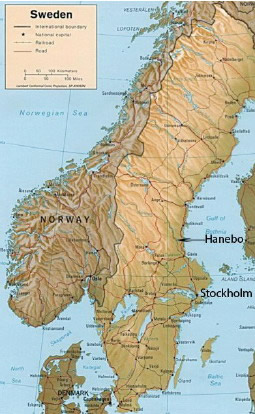Hans Nels Danielsson

Map of Sweden
Birthplace and Parents
Hans Nels Danielson was born in the farming village of Sörfly, Hanebo parish, Gävleborg län, Sweden on 17 February 1848, the child of Daniel Olofson and Karin Hansdotter. Sörfly is about 150 miles NNW of Stockholm.
In approximately 1869, Hans married Brita Olofsdotter (born 12 October 1847) and they had two children, Per (Peter), born 28 October 1870, and Karin (Carrie), born 14 June 1875. The name Brita is short for Birgitta, the Swedish form of Bridget. Saint Birgitta of Sweden was the 14th-century founder of the Bridgettine nuns. She is the patron saint of Europe.
Emigration from Sweden
On 9 June 1882 the family left, probably by train, for the port of Göteborg where they sailed for Hull, on the east coast of England. They travelled by train for four hours across England to the port of Liverpool and departed on the White Star Line steamship Baltic for New York. After a voyage of about 12 days, they arrived in New York harbor and were processed through immigration at Castle Garden, now known as Castle Clinton, in Battery Park at the foot of Manhattan. The Statue of Liberty would not be erected until 1886 and Ellis Island would not become an immigration processing center until 1892.Swedish Emigration records indicate that the family's destination was Moline, Illinois. The family departed from New York by train. We do not know if they travelled to or stayed in Moline.
Resettlement
By February, 1883, the family had become residents of Stockholm Township, Wright County, Minnesota, about 50 miles west of Minneapolis. We do not know why they came to this location. Stockholm Township was composed entirely of farms that had already been homesteaded before the family arrived. Hans rented a farm in section 3. The nearest village was Cokato, population about 300, 5 miles northeast. The family joined the Stockholm Evangelical Lutheran Church on 18 Oct 1883.
Originally part of the “Big Woods” country that was heavily forested before the arrival of white settlers, by the late 1800s Wright County, Minnesota was a land of farms situated on rolling hills with good soil and abundant lakes.
According to a local history, Hans and his family “located in section 3, Stockholm Township. Later they moved to section 9. Beginning in a primitive way, they in time achieved prosperity, and their 160 acres became a well cultivated farm”. (Curtiss-Wedge, Franklyn, History of Wright County Minnesota, 1915, p. 1044-5)
On 1 November 1884, in Wright County District Court, Hans filed his Declaration of Intention to become a citizen. We found no naturalization records for Brita, Peter or Carrie. Under an 1855 law, an immigrant woman became a U.S. citizen at the moment a judge's order naturalized her immigrant husband. Her only proof of U.S. citizenship would be a combination of the marriage certificate and her husband's naturalization record. As minors, the children derived citizenship from the "naturalization-by-marriage" of their mother.
On 24 Jul 1892, in their farmhouse on section 3 of Stockholm Township, Brita gave birth to her third child, Edwin Arnold Danielson. (Wright County Courthouse, Birth Record, Book 3, p. 112, line 19). After his mother's death at age 49 in 1897 and his father!s death at age 51 in 1899, Edwin was raised by his brother Peter and his sister Carrie on the home farm.
“After a brief illness of about a week Mr. Hans Danielson of Stockholm, died early Tuesday [7 Nov 1899] morning at his home in that town of blood poisoning. Mr. Danielson had been suffering from a small boil on his neck for some time previous to his recent illness and it was from this that blood poison set in proving fatal in less than a week. The funeral will take place Sunday at the Sw. Luth. Church of Stockholm.” (Cokato Enterprise, 9 November 1899)
All of Hans' land and other possessions at death were inventoried and valued under the direction of the Wright County Probate Court and were finally distributed in equal shares to his 3 children. Included in wearing apparel were: 2 suit clothes, 2 coats, 1 cap (fur), 4 overshirts, 1 dog skin coat and 2 pairs of shoes. Farm equipment included: 2 wagon hay rakes, 1 broad axe, 1 pair bob sleds, 1 wide tire wagon, 1 narrow tire wagon, 1 spring wagon, 1 boat, 1 woodbeam plow, 1 buggy robe, a pair of horse blankets, 1 heavy harness set, 1 light harness set, 1 harrow, and 1 buck saw. Livestock included: 1 bay mare (15 yr), 1 dark gray horse (5 yr), 2 hogs, 1 cow (7 yr), 1 cow (3 yr), 1 heifer (2 yr), 2 calfs, and 25 chickens. Finally there were: 66 bushels of corn, 200 bushels of wheat and 7 tons of wild hay. (Wright County Probate Court records, Minnesota History Center, microfilm SAM 231, roll 9, frames 1026-1046)